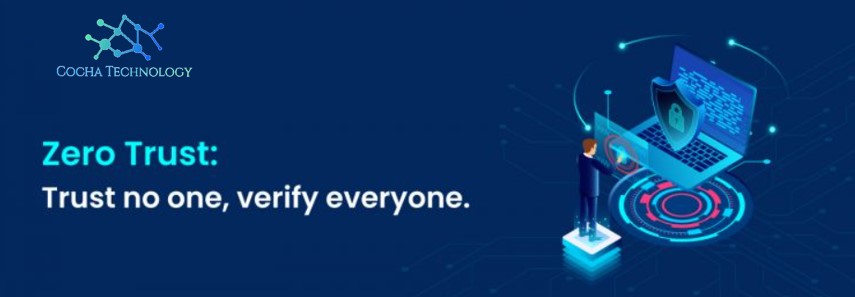Embracing Zero Trust
July 25, 2023

Redefining Cybersecurity for the Modern Era
In an increasingly interconnected and dynamic digital landscape, traditional perimeter-based security measures are proving inadequate in defending against sophisticated cyber threats. Enter Zero Trust, a revolutionary cybersecurity framework that challenges the traditional castle-and-moat approach by assuming no inherent trust and verifying every user, device, and transaction. In this blog post, we will delve into the concept of Zero Trust, its core principles, and the benefits it offers in safeguarding organizations against evolving cyber risks.
Understanding Zero Trust
Zero Trust is a security model that operates on the principle of “never trust, always verify.” Unlike traditional security models that rely on perimeter defenses, Zero Trust adopts a holistic approach by considering every user, device, application, and network as potentially untrusted. It assumes that threats can originate from both internal and external sources, making continuous verification and monitoring essential.
Key Principles of Zero Trust
- Least Privilege: Zero Trust advocates for granting the minimum level of access necessary for users, devices, and applications to perform their intended tasks. This principle ensures that privileges are allocated on a need-to-know basis, reducing the potential attack surface.
- Microsegmentation: Zero Trust emphasizes network segmentation at a granular level, dividing networks into smaller segments and enforcing strict access controls between them. This approach limits lateral movement within the network, containing potential breaches and minimizing the impact of an attack.
- Continuous Authentication: Zero Trust promotes continuous verification of user identities and device health throughout a session. Instead of relying solely on a one-time authentication event, continuous authentication monitors and analyzes user behavior, device posture, and contextual information to assess risk and enforce access controls in real-time.
- Security Monitoring and Analytics: Zero Trust incorporates comprehensive monitoring and analytics capabilities to detect anomalies, identify potential threats, and respond swiftly. By continuously analyzing network traffic, user activities, and security events, organizations can gain actionable insights and proactively address emerging security risks.

Benefits of Zero Trust
- Enhanced Security Posture: By assuming a zero-trust mindset, organizations can significantly improve their security posture. The granular access controls, continuous authentication, and network segmentation reduce the attack surface, limiting the lateral movement of threats and containing potential breaches.
- Improved Compliance: Zero Trust aligns with various industry regulations and compliance standards, such as GDPR, HIPAA, and PCI DSS. The principle of least privilege and continuous authentication help organizations meet compliance requirements by ensuring data privacy and enforcing strict access controls.
- Better Incident Response: Zero Trust’s emphasis on continuous monitoring and analytics enables organizations to detect security incidents promptly. This real-time visibility empowers incident response teams to take immediate action, mitigating the impact of security breaches and minimizing potential damage.
- Adaptability to Digital Transformation: As organizations embrace cloud computing, remote work, and bring-your-own-device (BYOD) policies, the Zero Trust model provides a flexible and adaptable security framework. It allows organizations to securely embrace new technologies and environments while maintaining stringent security controls.
Implementing Zero Trust
Transitioning to a Zero Trust model requires careful planning and a phased approach. Here are some key steps to consider:
- Assessment: Evaluate your existing security infrastructure, identify vulnerabilities, and determine areas where Zero Trust principles can be implemented effectively.
- Segmentation: Segment your network into smaller, more manageable zones and implement access controls between them. This ensures that even if one segment is compromised, the rest of the network remains protected.
- Continuous Authentication: Implement multi-factor authentication (MFA) and behavioral analytics to continuously authenticate users and devices. This helps identify anomalies and potential threats in real-time.
- Endpoint Security: Strengthen endpoint security by enforcing device compliance policies, implementing encryption, and deploying endpoint protection solutions to secure devices accessing your network.
- Monitoring and Analytics: Deploy advanced security monitoring and analytics tools to gain real-time insights into network traffic, user behavior, and security events. This enables proactive threat detection and rapid response.

Zero Trust represents a paradigm shift in cybersecurity, challenging the traditional perimeter-based security approach and adopting a comprehensive and adaptable framework. By implementing Zero Trust principles such as least privilege, microsegmentation, continuous authentication, and advanced monitoring, organizations can build resilient defenses against the evolving threat landscape. Embracing Zero Trust is not a one-time task but a continuous journey towards a more secure and trustworthy digital environment.
Have Any Question?
Call or email Cocha. We can help with your cybersecurity needs!
- (281) 607-0616
- info@cochatechnology.com




